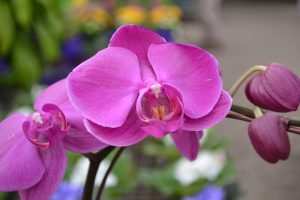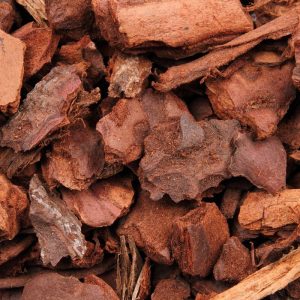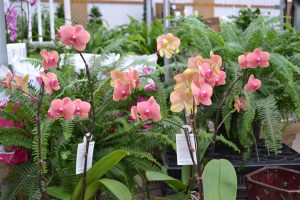Take one look at an Orchid and it is easy to see why they are one of the most popular houseplants around. With their exotic looking blooms, and stunning colours it is hard to pass them by. Many people mistakenly believe they are fussy, or difficult to care for, but for the most part Orchids are not difficult, just different.
In their natural settings Orchids grow in the jungle, most often attached to a tree.  They use their roots to grasp the trees bark and because of this are called epiphytes. Epiphytes do not require soil to grow, and use their roots to collect water from the humid air. They often have thick roots and stems that allow them to store and hold water for dryer times. Now imagine this same plant growing in your home and you will understand why it is important to have the right conditions. Of course, this does not mean you need to turn your home into a tropical paradise, but there are some things you can do to ensure success with an Orchid.
They use their roots to grasp the trees bark and because of this are called epiphytes. Epiphytes do not require soil to grow, and use their roots to collect water from the humid air. They often have thick roots and stems that allow them to store and hold water for dryer times. Now imagine this same plant growing in your home and you will understand why it is important to have the right conditions. Of course, this does not mean you need to turn your home into a tropical paradise, but there are some things you can do to ensure success with an Orchid.
There are about 30,000 species of Orchids worldwide, but not all of them will thrive in a windowsill. Years of research and study has brought forward the varieties that are best suited to growing in your home and most often at the top of the list is the Phalaenopsis (fayl-eh-nop-sis) Orchid. These are one of the most well-known varieties and the one you will most often see in Garden Centres.
Phalaenopsis Orchids come in a variety of shades of white, pink, mauve, and more, often  with their own unique colourful veining and spotting. Each spike will be loaded with blooms and they often bloom almost year long. Phalaenopsis Orchids have short rest times meaning there may be only a few weeks when they are not blooming.
with their own unique colourful veining and spotting. Each spike will be loaded with blooms and they often bloom almost year long. Phalaenopsis Orchids have short rest times meaning there may be only a few weeks when they are not blooming.
The first thing your Phalaenopsis needs is light: though likely not as much as you think. In its natural habitat, attached to the bark of trees it would receive filtered light. In a home setting this means a bright area, but not necessarily direct sunlight.
Next it is important to consider water, which will be directly linked to the potting medium used.  Orchid bark is most commonly used to pot orchids as it holds some water, but also allows for many air pockets throughout so the roots of the plant do not sit in water. Some orchids are grown in sphagnum moss, but this can be trickier as it can become tightly packed and not allowed to dry out. If your orchid is in bark it can usually be watered weekly, and if in moss it is best to wait until the top is dry before watering again. If your home is dry you can place your potted orchid over a pebble tray (a flat tray with small rocks, glass, or marbles) to increase humidity.
Orchid bark is most commonly used to pot orchids as it holds some water, but also allows for many air pockets throughout so the roots of the plant do not sit in water. Some orchids are grown in sphagnum moss, but this can be trickier as it can become tightly packed and not allowed to dry out. If your orchid is in bark it can usually be watered weekly, and if in moss it is best to wait until the top is dry before watering again. If your home is dry you can place your potted orchid over a pebble tray (a flat tray with small rocks, glass, or marbles) to increase humidity.
Along with your potting medium it is important for an orchid to be in the right type of pot. I prefer to use an orchid pot which is specially designed for orchids. They have good drainage holes in the bottom, and openings along the sides to help with airflow. These pots come in many colours, sizes, and styles and you are sure to find one to suit your décor. To keep your orchid healthy, it should be repotted every year, in fresh bark. It is a good idea to do this directly after your orchid blooms.
Phalaenopsis Orchids will usually bloom from fall to spring, and then have a rest period in June or July. During this rest period it will grow one to two new leaves and prepare for the next bloom cycle. Once your orchid has finished blooming cut off the  stem leaving two nodes (these are the little brown lines on the stem, directly below the flowers). One of these nodes will then sprout and usually produce flowers within eight to twelve weeks. If your orchid has not flowered by the end of this time it may need a slight dip in temperature to indicate the lower temperatures of fall. Place it in an area a few degrees cooler for several nights and then move it back to its original spot.
stem leaving two nodes (these are the little brown lines on the stem, directly below the flowers). One of these nodes will then sprout and usually produce flowers within eight to twelve weeks. If your orchid has not flowered by the end of this time it may need a slight dip in temperature to indicate the lower temperatures of fall. Place it in an area a few degrees cooler for several nights and then move it back to its original spot.
Orchids bring a touch of tropical to any home, with their large, elegant blooms, and large, dark green leaves. They are easy to care for, can be enjoyed for months on end, and make a great gift. These stunning flowers remain a favourite of mine, and hopefully, will become a favourite of yours too.
